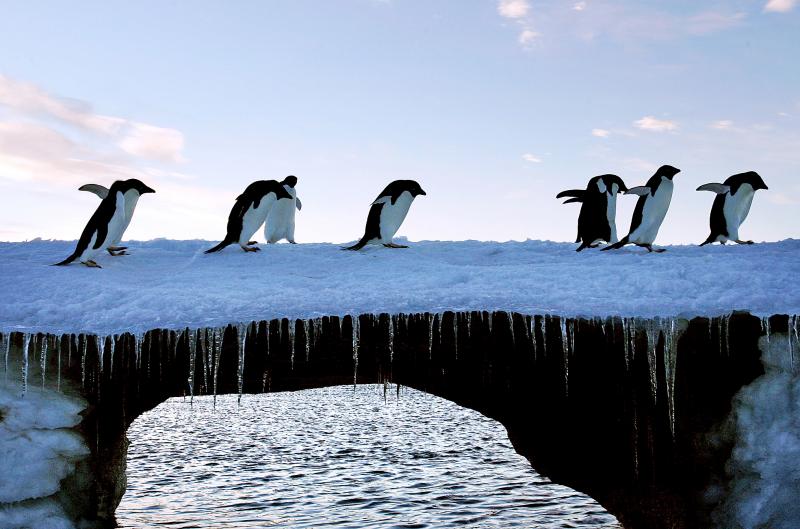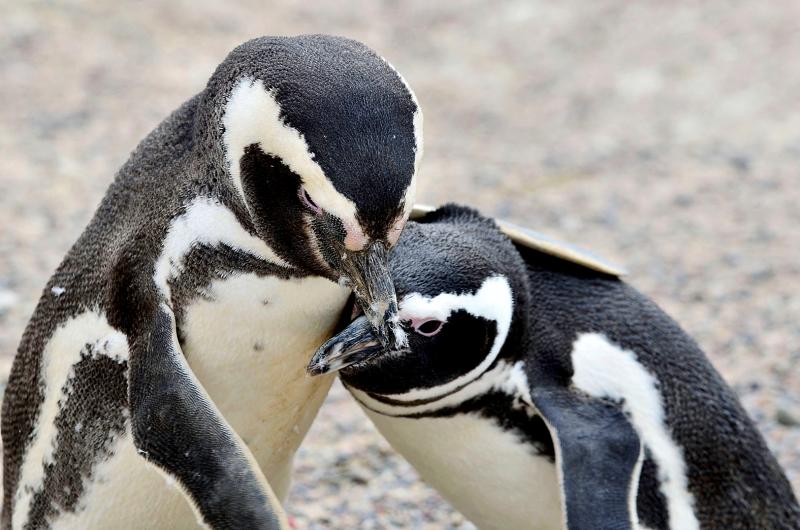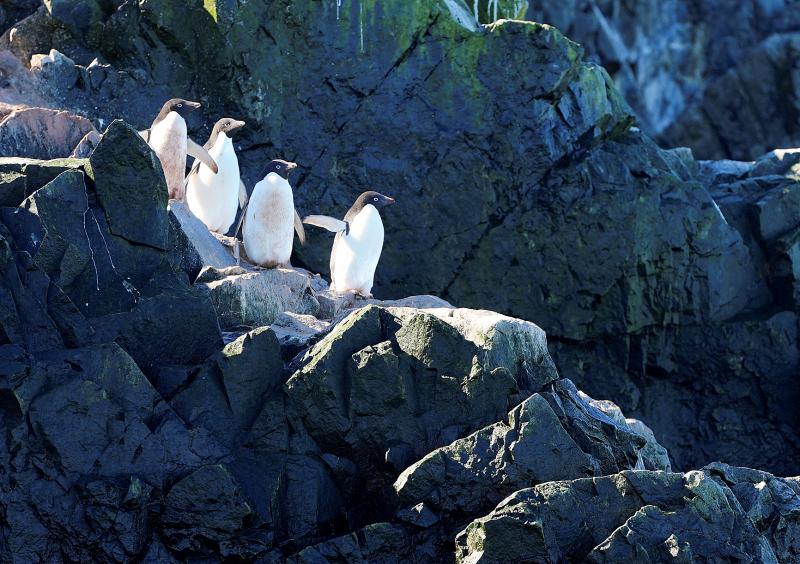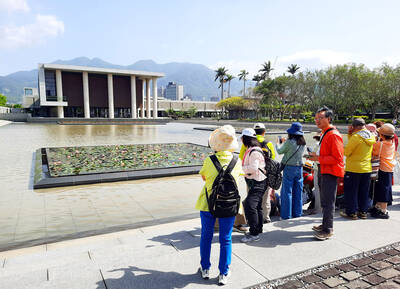The evolution of penguins from their flying seabird ancestors into the flightless denizens of marine environments from frigid Antarctica to the tropical Galapagos Islands is among the wonders of the animal kingdom.
Researchers on Tuesday offered the most thorough examination to date of the history of penguins dating back to their origins more than 60 million years ago, including identifying a suite of genes crucial in adaptations related to underwater vision, long dives, body temperature regulation, diet and body size.
The researchers sequenced the genomes of the 20 living penguin species and subspecies. With more than three quarters of known penguin species now extinct, the researchers also included in their analysis 50 fossil species using skeletal data.

Photo: Reuters
The researchers said penguins evolved from a common ancestor shared with a group of seabirds that includes albatrosses and petrels. Penguins first evolved the ability to dive, like a puffin, and subsequently lost the ability to fly as they adapted to an aquatic realm, becoming excellent swimmers and divers.
The earliest-known penguin — dating back to 61 million years ago, about 5 million years after the mass extinction event that doomed the dinosaurs — is called Waimanu manneringi, from New Zealand.
“To me, penguins are a perfect example of a major evolutionary transition, like the evolution of an aquatic lifestyle in whales or flight in bats,” said avian paleontologist Daniel Ksepka of the Bruce Museum in Greenwich, Connecticut, co-author of the study published in the journal Nature Communications.

Photo: Reuters
“We know penguins evolved from flying birds, but that happened over 60 million years ago and we need to look to the fossil record to piece together where, when and how that happened. Plus, penguins are ridiculously charming creatures. They love, they fight, they steal, and because of their funny upright posture it’s really easy to imagine them having all the same motivations as people,” Ksepka said.
The study illustrated how global temperature changes — oscillations between cold and warm periods — and shifts in major ocean currents have been important drivers of penguin evolution.
“We estimated how populations of each penguin species fluctuated over the last 250,000 years from signatures left in their genome by population crashes and booms,” Ksepka said. “The waxing and waning of ice sheets had a big impact on penguins, and species vulnerable to receding sea ice may suffer greatly from future global heating.”

Photo: Reuters
Penguins also were found to exhibit the lowest evolutionary rates yet detected among birds.
Penguins live primarily in the Southern Hemisphere, including species like the Adelie penguin along Antarctica’s coastlines. The Galapagos penguin is the only one found north of the equator.
University of Copenhagen postdoctoral researcher and study lead author Theresa Cole said the research uncovered a variety of genes likely involved in unique penguin physiological adaptations.
They show gene mutations that shift their vision toward the blue end of the color spectrum. Blue light penetrates more deeply into the ocean than light at the red end of the spectrum, so this trait helped fine-tune vision for low-light, underwater acuity.
Genes that help birds detect salty and sour tastes are active in penguins. But genes that help detect bitter, sweet and savory tastes are inactivated. Those may no longer be needed as penguins forage in cold, salty water and typically swallow prey including fish, shrimp and squid whole.
Penguins exhibit a flattening and stiffening of their wing bones and a reduction of their flight feathers into tiny structures that help convert wings into flippers. They also reduced the air spaces in the skeleton and increased bone wall thickness to increase diving efficiency, as well as adding the ability to store more oxygen in their muscles for long dives.
Penguins were once much larger than today’s species. One species, Kumimanu biceae, that inhabited New Zealand between 55 and 60 million years ago stood about 6 feet (1.8 meters) tall. The largest extant species, the emperor penguin, is about 3 feet (1 meter) tall.

When the South Vietnamese capital of Saigon fell to the North Vietnamese forces 50 years ago this week, it prompted a mass exodus of some 2 million people — hundreds of thousands fleeing perilously on small boats across open water to escape the communist regime. Many ultimately settled in Southern California’s Orange County in an area now known as “Little Saigon,” not far from Marine Corps Base Camp Pendleton, where the first refugees were airlifted upon reaching the US. The diaspora now also has significant populations in Virginia, Texas and Washington state, as well as in countries including France and Australia.

On April 17, Chinese Nationalist Party (KMT) Chairman Eric Chu (朱立倫) launched a bold campaign to revive and revitalize the KMT base by calling for an impromptu rally at the Taipei prosecutor’s offices to protest recent arrests of KMT recall campaigners over allegations of forgery and fraud involving signatures of dead voters. The protest had no time to apply for permits and was illegal, but that played into the sense of opposition grievance at alleged weaponization of the judiciary by the Democratic Progressive Party (DPP) to “annihilate” the opposition parties. Blamed for faltering recall campaigns and faced with a KMT chair

Article 2 of the Additional Articles of the Constitution of the Republic of China (中華民國憲法增修條文) stipulates that upon a vote of no confidence in the premier, the president can dissolve the legislature within 10 days. If the legislature is dissolved, a new legislative election must be held within 60 days, and the legislators’ terms will then be reckoned from that election. Two weeks ago Taipei Mayor Chiang Wan-an (蔣萬安) of the Chinese Nationalist Party (KMT) proposed that the legislature hold a vote of no confidence in the premier and dare the president to dissolve the legislature. The legislature is currently controlled

Dull functional structures dominate Taiwan’s cityscapes. But that’s slowly changing, thanks to talented architects and patrons with deep pockets. Since the start of the 21st century, the country has gained several alluring landmark buildings, including the two described below. NUNG CHAN MONASTERY Dharma Drum Mountain (法鼓山, DDM) is one of Taiwan’s most prominent religious organizations. Under the leadership of Buddhist Master Sheng Yen (聖嚴), who died in 2009, it developed into an international Buddhist foundation active in the spiritual, cultural and educational spheres. Since 2005, DDM’s principal base has been its sprawling hillside complex in New Taipei City’s Jinshan District (金山). But